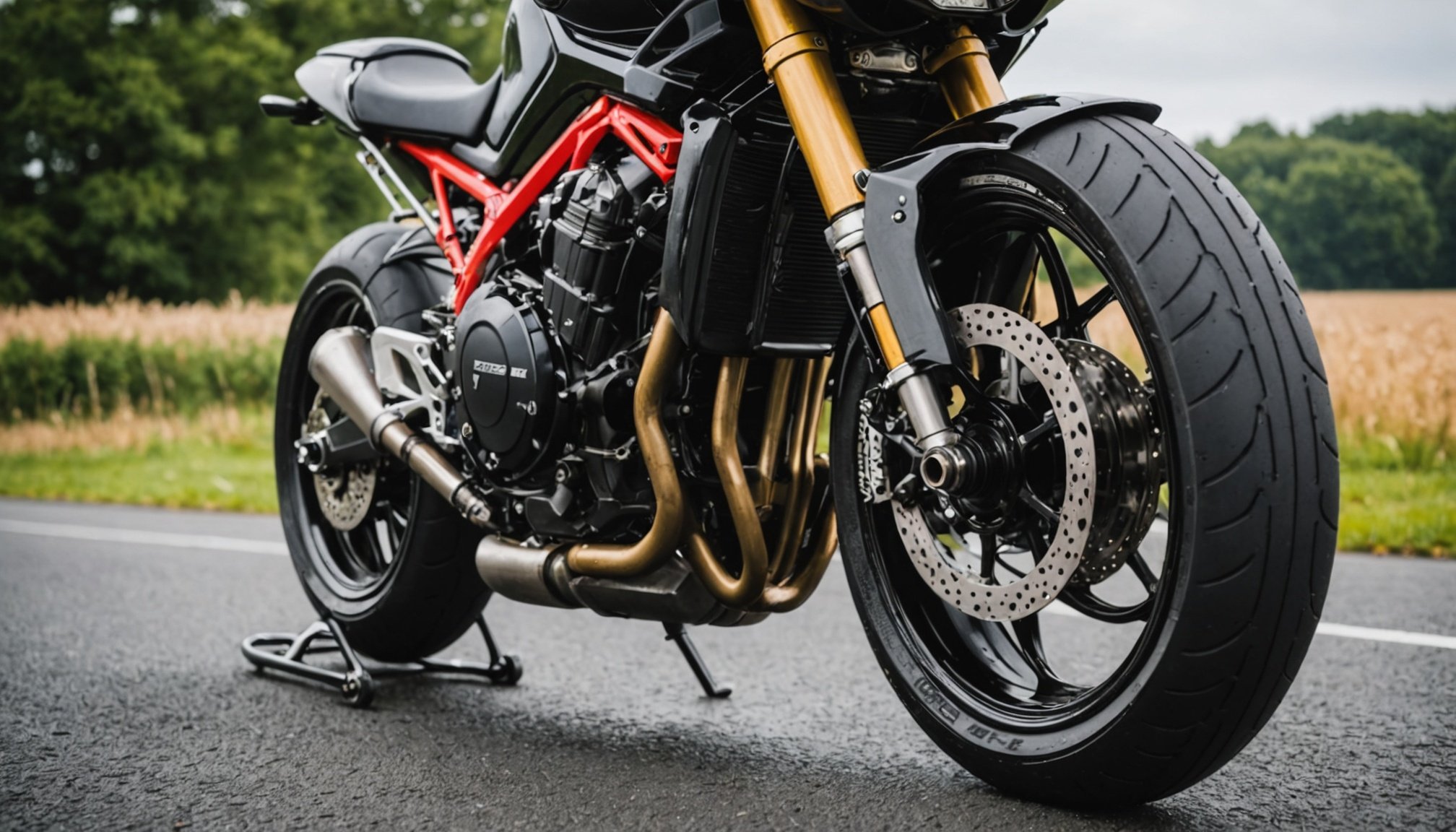Mastering Sport Bike Tire Inflation: Your Guide to Navigating the UK’s Changing Weather
Understanding the Importance of Tire Pressure
When it comes to riding your bike, whether it’s a road bike, mountain bike, or gravel bike, one of the most critical factors that can make or break your ride is tire pressure. Proper tire pressure can significantly impact your bike’s performance, safety, and overall riding experience. Here’s why it’s so crucial:
Safety and Control
“Tire pressure is like the foundation of your house,” says John, a seasoned mountain biker. “If it’s off, everything else can be compromised.” Incorrect tire pressure can lead to reduced grip, increased risk of tire punctures, and poorer handling, especially in adverse weather conditions.
Topic to read : Mastering Chain Alignment for Your Sport Bike: Ensure Seamless Performance in UK Climate Conditions
Performance and Efficiency
The right tire pressure can enhance your bike’s speed and efficiency. For instance, underinflated tires can cause more rolling resistance, making your ride more strenuous and less enjoyable. On the other hand, overinflated tires might provide less grip, particularly on gravel or mountain trails.
Longevity of Tires
Proper tire pressure also extends the life of your tires. Underinflated tires are more prone to wear and tear, as well as damage from road hazards. Here is a detailed list of why maintaining the right tire pressure is essential:
In parallel : Elevate Your Sport Bike”s Braking Performance: A Comprehensive Guide to Upgrades for UK Racing Tracks
- Safety: Ensures better grip and control on the road.
- Performance: Optimizes speed and efficiency.
- Longevity: Extends the life of your tires.
- Comfort: Provides a smoother ride by absorbing road vibrations better.
- Fuel Efficiency: For motorcycles, proper tire pressure can improve fuel efficiency.
Reading and Understanding Tire Codes
Before you can adjust your tire pressure, you need to understand the tire codes on your bike. Here’s a breakdown of what these codes mean:
Load Index and Load Range
The load index is a numerical code that indicates the maximum load each tire can carry at a given pressure. For example, a load index of 91 means the tire can support up to 615 kg at the recommended pressure[4].
Speed Rating
The speed rating is denoted by a letter (e.g., H, V, W) and indicates the maximum speed the tire is designed to handle. For instance, a speed rating of ‘H’ means the tire can handle speeds up to 210 km/h[4].
Here is a table summarizing some common speed ratings:
| Speed Rating | Max Speed (km/h) | Max Speed (mph) |
|---|---|---|
| H | 210 | 130 |
| V | 240 | 149 |
| W | 270 | 168 |
| Y | 300 | 186 |
How to Check and Adjust Tire Pressure
Checking and adjusting tire pressure is a straightforward process, but it requires some attention to detail.
Tools You Need
- A reliable tire pressure gauge
- A pump or compressor (like the AstroAI Cordless Tire Inflator)[3]
Steps to Follow
- Check the Recommended Pressure:
- Look for the recommended tire pressure on the sidewall of your tire or in your bike’s manual.
- Note that there are different pressures for the front and rear wheels.
- Use a Reliable Gauge:
- Ensure your tire pressure gauge is accurate and easy to read.
- Digital gauges like those on the AstroAI inflator are highly recommended for their precision.
- Inflate to the Right Pressure:
- Use your pump or compressor to inflate the tire to the recommended pressure.
- For example, if your tire requires 40 PSI, make sure to set the gauge to this value and inflate accordingly.
Here is an example of how to use a portable air compressor:
- Select the Pressure Scale: Choose between PSI, KPA, or KG/CM.
- Set the Desired Pressure: Input the recommended pressure into the gauge.
- Start the Compressor: Press the start button and let the compressor do the work until it reaches the desired pressure.
Navigating Different Weather Conditions
The UK’s weather can be quite unpredictable, and this variability affects how you should manage your tire pressure.
Rainy Conditions
In rainy conditions, you might want to slightly lower your tire pressure to increase grip. Here’s why:
- Better Traction: Lower pressure increases the contact patch of the tire with the road, providing better traction on wet surfaces.
- Caution: However, be careful not to underinflate too much, as this can lead to increased risk of punctures and reduced handling.
Dry Conditions
In dry conditions, you can stick to the recommended tire pressure or slightly increase it for better efficiency and speed.
Gravel and Mountain Biking
For gravel and mountain biking, the approach is slightly different:
- Gravel Biking: You might want to run slightly lower pressures to handle the rough terrain and improve grip.
- Mountain Biking: Even lower pressures are often used to absorb shocks and improve traction on trails.
Here are some general guidelines for adjusting tire pressure based on weather and terrain:
- Rainy Conditions: -1 to -2 PSI from the recommended pressure.
- Dry Conditions: +1 to +2 PSI from the recommended pressure.
- Gravel Biking: -2 to -4 PSI from the recommended pressure.
- Mountain Biking: -4 to -6 PSI from the recommended pressure.
Practical Tips for Riders
Here are some practical tips to keep in mind when managing your bike’s tire pressure:
Regular Checks
- Check your tire pressure at least once a week, and before long rides.
- Use a reliable gauge to ensure accuracy.
Adjust for Load
- If you’re carrying extra load, such as a passenger or heavy gear, adjust the tire pressure accordingly.
- Refer to the load index and load range on your tire to determine the correct pressure.
Consider the Terrain
- Adjust your tire pressure based on the terrain you’ll be riding on.
- For example, if you’re transitioning from road to gravel, lower your tire pressure to improve grip.
Maintenance
- Regularly inspect your tires for wear and tear.
- Replace your tires when necessary to ensure safety and performance.
Real-Life Examples and Anecdotes
Here are a few real-life examples that highlight the importance of proper tire pressure:
A Mountain Biking Adventure
“I once went on a mountain biking trip in the Scottish Highlands,” recalls Sarah, an avid mountain biker. “I had set my tire pressure too low, thinking it would give me better grip. However, it ended up being too low, and I got a puncture halfway through the trail. It was a hard lesson learned – always check and adjust your tire pressure according to the terrain and conditions.”
A Road Riding Experience
“During a road ride in the rain, I realized my tires were overinflated,” says Mark, a road cyclist. “I lowered the pressure slightly, and it made a huge difference. The grip was much better, and I felt more confident riding in the wet conditions.”
Mastering sport bike tire inflation is not just about following a set of rules; it’s about understanding how different factors like weather, terrain, and load affect your ride. By knowing how to read tire codes, check and adjust tire pressure, and adapt to changing conditions, you can ensure a safer, more enjoyable, and more efficient ride.
Whether you’re riding a road bike, mountain bike, or gravel bike, or even your motorcycle, the principles remain the same: make sure your tire pressure is right for the conditions you’re in. Here’s a final checklist to keep in mind:
- Check Tire Codes: Understand the load index and speed rating.
- Use the Right Tools: Invest in a reliable tire pressure gauge and pump.
- Adjust for Conditions: Lower pressure for wet or rough terrain, and increase for dry conditions.
- Regular Maintenance: Check tire pressure regularly and replace tires when necessary.
By following these guidelines, you’ll be well on your way to mastering the art of tire inflation and enjoying every mile of your ride, no matter the weather.






